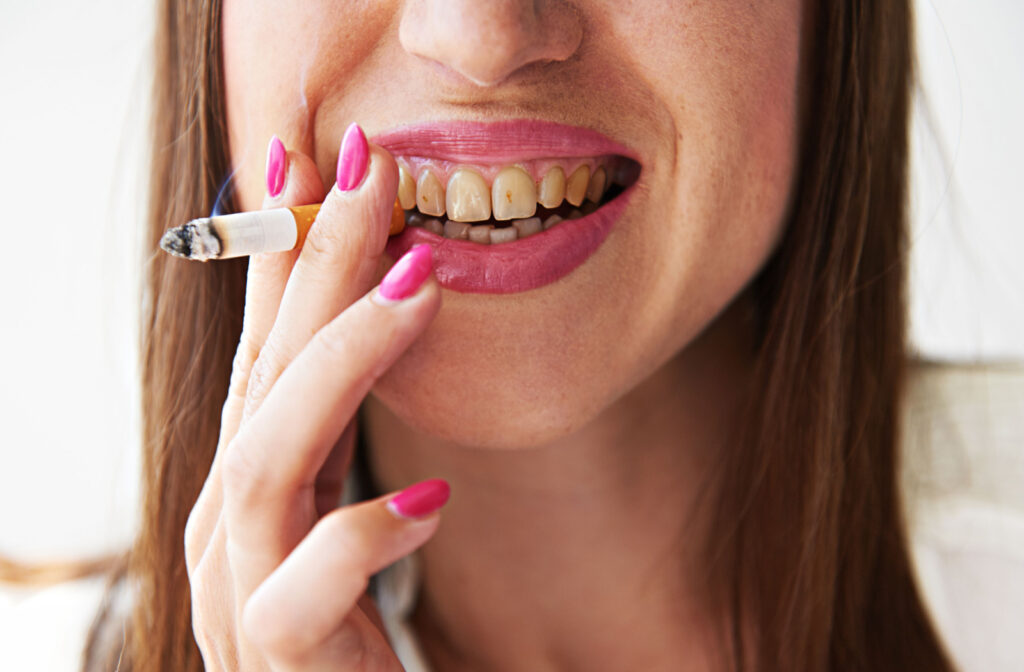A bright, shining smile; there’s almost nothing like it. We all deserve to be able to smile bright and white to show off our healthy teeth. But sometimes, tooth discolouration can get in the way, turning our teeth yellow and dark. What causes tooth discolouration?
Your teeth naturally could just be yellow or darker. However, if the colour change is recent, it could be due to:
- Plaque and tartar
- Food stains
- Gum disease
- Tooth decay
- Tobacco usage
If you’ve noticed recent discolouration, reach out to your dentist. They can perform a proper in-office dental cleaning and help determine what’s causing your tooth discolouration.
Why Do Teeth Get Discoloured?
Despite what many people believe, teeth aren’t naturally white. They’re more often naturally yellow, even if every commercial shows bright and shining pearly whites.
This is due to a mix of 2 parts of your teeth:
- The enamel: This is the hard outer protective layer of the teeth. This layer is often translucent to a certain degree.
- The dentin: This is the inner layer. This layer has a yellowish hue that can show through the enamel.
Usually, tooth discolouration isn’t anything more than an aesthetic concern. If no external factors are at play, your teeth may naturally be a little yellower than most. However, this isn’t always the case. Sometimes, other factors can contribute to tooth discolouration.
What Can Cause Discolouration at the Gumline?
When you have discolouration along the gumline, it may be concerning at first. If there’s a significant colour change between the tips of your teeth and the base, there’s likely something else at work here.
It could be due to:
- Plaque and tartar
- Food stains
- Gum disease
- Tooth decay
- Tobacco usage
Noticeable discolouration isn’t always a severe problem, but it could be a sign that something’s wrong. If you’ve noticed a significant shift in the colour of your teeth, reach out to your dentist for an appointment; they can help determine what’s causing the change.
Plaque & Tartar
Your mouth is a breeding ground for bacteria, no matter how well you brush. It’s like a tiny ecosystem; they thrive on the foods you eat. It’s part of why oral hygiene is so important! It helps keep these bacteria under control.
These bacteria can eventually form plaque, a sticky film that covers the surface of your teeth. Over time, if it’s not removed, it can harden and become tartar. Plague and tartar can cause visible tooth discolouration along the gumline that can be difficult to remove with brushing or flossing. Fortunately, your dentist can help with a professional in-office dental cleaning.
Food Stains

When you eat food or drink a refreshing beverage, it can often leave residue behind. Coffee, tea, red wine, and berries can stain your teeth with their pigments. This is often due to “tannins,” a polyphenol that makes it easier for pigment molecules to stick to tooth enamel. Over time, these stains can accumulate and cause noticeable discolouration.
It can help to rinse your mouth after eating or drinking. If you consume anything and notice immediate discolouration, try brushing your teeth—this can help remove the stains before they set in.
Gum Disease
Your gums are important to your overall health, but they aren’t immune to problems. They can become red, swollen, and inflamed. This is often due to “periodontitis,” more commonly called “gum disease.”
This inflammation can lead to several different problems depending on how far it progresses. In earlier stages, it could be as simple as the gums being more sensitive and bleeding easily. This can mix with existing plaque and tartar and stain the teeth.
In later stages, the gums can recede, revealing parts of the teeth previously covered. It can even damage underlying bone tissue and cause grey or yellow discolouration around the base of your teeth. If you have sensitive gums or have recently noticed bleeding near the base of your teeth, visit your dentist to get checked for gum diseases.
Tooth Decay
Tooth decay isn’t just a cavity; it’s also an erosion of the tooth’s protective layer. When enamel begins to wear down, it weakens the tooth’s structure and opens the door for more surface area that stains can cling to. Try to keep an eye out for:
- Dark brown or black spots on the teeth
- Tooth sensitivity
- Pain when biting down or clenching your jaw
If you notice these symptoms, you may be experiencing a cavity.
Tobacco
Tobacco use, whether it’s smoking or chewing, can turn teeth dark and unsightly. The nicotine and tar present in tobacco are intensely pigmented and can lead to deep, stubborn staining near the gumline.
Quitting smoking has plenty of health benefits, ranging from improved heart health to a lower risk of lung cancer. If you use tobacco in any way, it can help to speak with a healthcare professional to discuss quitting.
Tips for Preventing Discolouration
Fortunately, it can be simple to prevent tooth discolouration—as long as no conditions are causing the problem. Prevention is often simpler than treatment. So try to:
- Brush your teeth at least 2 times a day, for 2 minutes at a time, with a soft-bristled toothbrush and fluoride toothpaste
- Floss once a day, making sure you reach between every tooth and along the gumline
- Use mouthwash regularly
- Rinse your mouth after eating or drinking any staining foods or drinks
And remember to visit your dentist for routine exams and cleanings. This way, you can keep your teeth bright, healthy, and clean—all while lowering the risk of developing a dental problem.
Can a Dentist Help with Tooth Staining?
If you have discolouration on your teeth, contact our Sundance Dental Clinic team. We can schedule a proper dental cleaning and help you treat your discolouration, and we’ll check for the cause of your problem. You deserve to smile bright, so request an appointment with us today!




